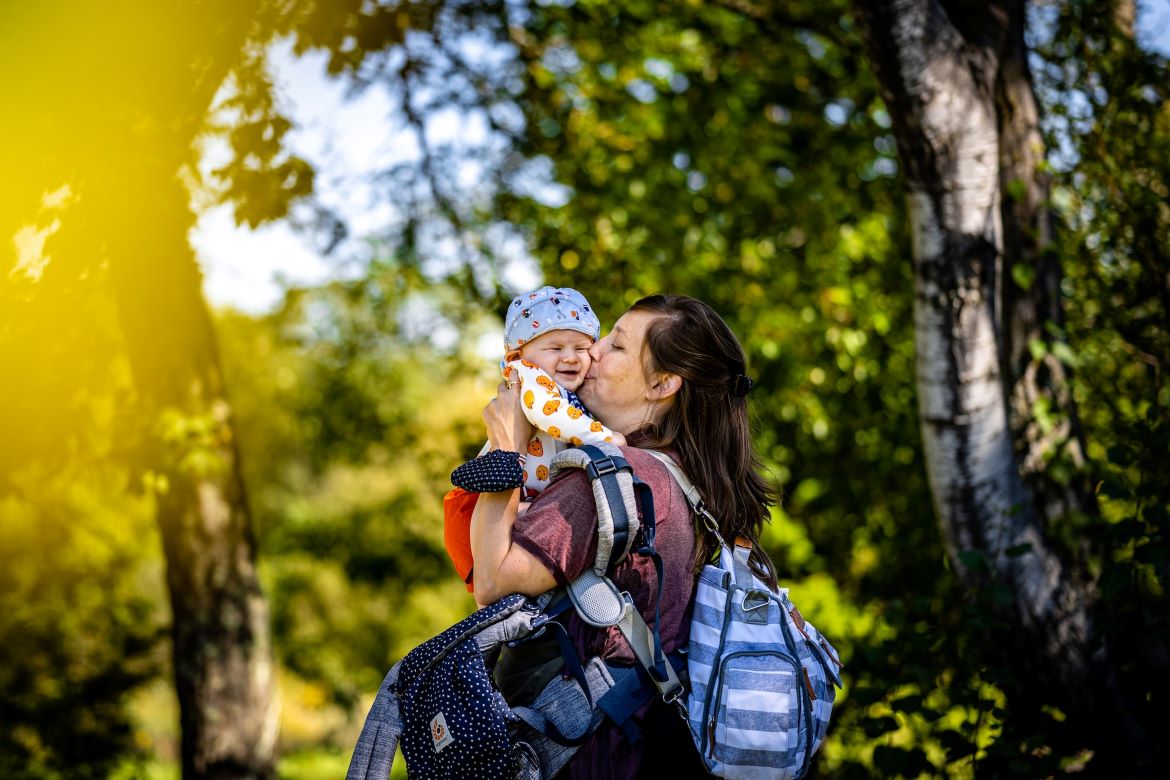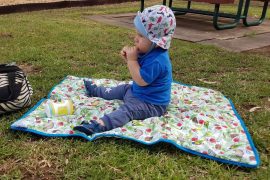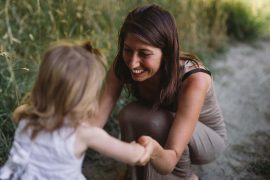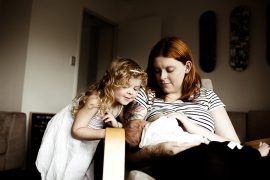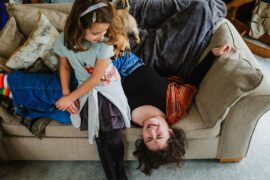By Emma Jenkins
I have to confess I did not actually know that ‘infant mental health week’ was a thing until now, but I’m so glad it is! This is an area so close to my heart. And it is times like these that help us to see that such seemingly simple things we are doing – like engaging with our babies and responding to their basic needs – are an incredible gift for them in setting them up well for the rest of their life.
What is secure attachment?
In general, I’m sure we all agree that as parents, we of course want the best for our babies, and are trying with every ounce of the resources we have to raise them well. If babies have this desire in a caregiver, then of course they have what they need! And you are doing an amazing job in this – at times – shitty, frustrating, judgment-laden parenting game. So firstly, a little warning, this science may be a little bit hard to hear at times but be assured its purpose is to educate against the old view that too much cuddling and attention in infancy is damaging. It is about providing some scientific evidence for theories and practices, and giving you a bit of ground to stand on if your 70- or 90-year-old relative (as mine did) tells you to ‘put that (2-week-old) baby down or you’ll spoil it!’ (true story). There is also a difference between ‘attachment parenting’ and true attachment theory or what we call a secure attachment, as the former tends to purport the view that mums and babies are pretty much together at all times. A secure attachment can of course exist where babies are exposed to periods of stress and crying without cuddles, and of course this can often be beneficial and necessary in teaching both mums and babies. Have I let my baby cry at times for various reasons (occasionally including sleep)? Yes. Do I believe he shows a secure attachment pattern? Pretty much at the moment, yes. Some important considerations here are different stages of infancy (age), developmental level and understanding of the world around them.
Put simply, ‘attachment’ is about the way we relate to our primary caregivers and how that translates to the way we relate to the world. The development of a secure attachment was once explained to me by the tent metaphor as a secure base – when we are out in the bush/forest, if we feel that we have a safe and warm, cosy bed and shower to return home to, we might be more willing to go for a swim, climb a bit higher or run through a bit more dirt or challenging situation. If we know that we only have a flimsy tent without much security, we are likely to feel insecure and be afraid of moving too far, doing anything too ‘risky’ or getting our hands dirty, as we don’t have the resources to feel comforted and safe again. This is the same as child rearing – when a child falls down and learns that their caregiver will be there to help them feel safe and supported, they will be more likely to try out more challenging situations again and explore their environment in future. If they don’t receive that message it can thwart their development in many ways.
Put simply, ‘attachment’ is about the way we relate to our primary caregivers and how that translates to the way we relate to the world.
The myths, and the facts
MYTH 1: As long as babies are physically safe, fed, and warm, they don’t have a real ‘need’ that requires our response.
FACT: Harlow’s monkeys needed to cuddle, not just eat.
The old ‘if they’re fed, they’re fine’ argument debunked. In 1958, psychologist Henry Harlow didn’t agree with the old assumption that a cuddled baby would become spoilt, so he did experiments with beautiful baby Rhesus Monkeys (completely heartbreaking experiments, but did prove important scientific points). He made sticks into what I’ll call a ‘fake-comfy mummy’, packed with cloth to make her cuddly, and a ‘fake-uncomfy mummy’ out of wire that had bottles attached for physical nourishment.
The babies ALL preferred the comfy mummy at all times. Even when she didn’t have food attached, they’d just run over to wire-mummy for a quick drink and come straight back. They all recognised their individual ‘mum’ – choosing the same one every time, and they needed ‘her’ around in a stressful situation or they’d become paralysed with fear. Without a comfy cloth mummy around at all, they developed digestive problems and physical sickness, despite having exactly the same milk as the other monkeys who had access to both. All the babies also showed a range of ongoing behavioural disturbances that demonstrated the trauma they had faced being away from a real primary caregiver, and gave an insight in to the seriousness and horror of ongoing separation and stress at such an early age.
So overall, this showed that there was so much more to a caregiver-child relationship than just milk, and paved the way in to understanding the importance of psychological nourishment of babies.
MYTH 2: Babies don’t remember what happens to them in infancy.
FACT: As a recent book by Bessel Van Der Kolk states: ‘The Body Keeps the Score’ – i.e. the memories ARE stored in the form of changes in the architecture of the brain! Roughly from age 0-3, many of the foundations of the brain that are related to ongoing mental health and behaviour are literally laid down. These memories show up through behavioural, gestural and interactive markers in life. That is totally crazy to think about, but it is true that early childhood adverse experiences, psychological distress, PHYSICALLY leaves a mark in the brain – mostly in the prefrontal cortex including decreased frontal lobe functioning and increased limbic system (amygdala) sensitivity. These changes lead to various behavioural markers such as more extreme stress reactions to minor/everyday challenges, difficulties with self regulation, problem solving difficulties, impulsiveness, difficulties in executive functioning such as attention and organisation of ideas, behavioural difficulites, difficulties relating to people… the list goes on. Early trauma in the form of ongoing stress leads to implicit memories that are physically seen in the brain and in the body later in life.
We are the foundation of security that builds resilient children and adults.
MYTH 3: The brain is already built (or planned) when a baby is born, so it is not impacted by the environment.
FACT: All humans need the right sorts of social and interactive experiences for the brain to keep growing in a normal way. Even if they have the right genetic makeup, a lot of stress through adverse experiences can and does detrimentally impact brain development. Babies need to be stimulated, and need to have love and care by a primary caregiver in order to understand that they are safe, fostering the rest of the billions of tiny connections to keep growing as they do in the brain for at least 25 years.
MYTH 4: A nurturing style of parenting breeds pansy or spoilt children with no resilience.
FACT: If we are ‘responsive’ to our infants’ needs, this is different to giving them everything they want, and it is also different to rescuing them from every possible adverse experience. It is true that resilience is built by overcoming difficulties, therefore we need our babies to know that ‘when something goes wrong’ (and we need to allow them to take these chances, within reason), that we will be there to help them cope with it. We are the foundation of security that builds resilient children and adults. All the research tells us that the more responsive we are to infants early on, the more independent they will be later in life. It gives them more confidence to try challenging situations and take risks, because they know that they will be ok if they fail, they will have a way to get through it when something goes wrong.
BUT…. THE GOOD NEWS!
So this might sound all dark and gloomy when we realise that early problems have such long-lasting consequences. HOWEVER… the best part is that the area of the brain that has been impacted by ‘trauma’ or ongoing stress is also the part of the brain that is the most ‘plastic’.
Brains can change, under the right circumstances.
In Norman Doidge’s great book ‘The Brain that Changes Itself’, revolutionary science was described, where people managed incredible things that doctors thought they never would. They did it through practice, literally ‘training their brains’. That means they pruned away the unnecessary connections in the brain and strengthened the ones that were most important. Given that babies are still growing billions of connections in the brain, and will go through several stages of ‘pruning’ and strengthening these connections in childhood and adolescence, this means we can change things in the environment to help our babies foster these important connections that lead to later outcomes. We can help them see that actually the world can be safe, they are loved, and they can try new things.
So what can we do to boost infant mental health?
Lick your rats! (Physical and emotional connection)
Our babies will not be spoilt by being cuddled.
Our babies will not be spoilt by being cuddled. Rat studies have shown that an infant’s genes and DNA are literally changed by a mother’s nurturing behaviour. The DNA in baby rats who, when stressed out by something, are licked and groomed by mum, is different to the DNA of the rats whose mothers show ‘low grooming behaviour’. This was especially important during the very first weeks of life. The same positive impacts are seen in the rats’ behaviour – where rats who were very nurtured showed calm behaviours, more willing and able to face challenges. Rats whose mothers didn’t lick them much under stress showed anxious behaviours and were not willing to explore and try novel situations. This translates to babies needing the physical love and nurturing that we provide them under stress! So lick your rats mummas, and they’ll be alright!
Show your baby you understand their feelings and co-regulate.
Stress is normal! And, we can help moderate a stress response – and when it is moderated, the brain is not damaged in the way described above. We can be there to respond to our babies’ needs. No, that doesn’t mean we need to give them every chocolate bar they demand, but it does mean being sensitive and being able to tune in to their emotions. Co-regulating is a big part of that, and it means being with your baby in their intense feelings – of course not wailing and crying with them, but indicating you understand they are having that intense feeling, labeling the feeling out loud, and then gradually modeling more calm behaviour, letting them know they are safe and OK, and helping them to calm with soothing, rhythmic sounds and motions. This co-regulation eventually helps babies to learn emotional regulation and how to soothe themselves in later life.

